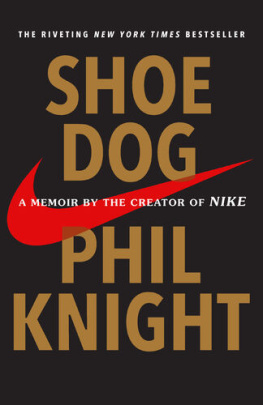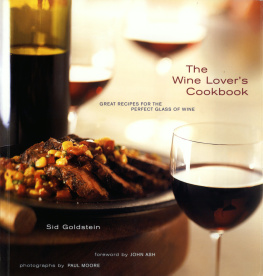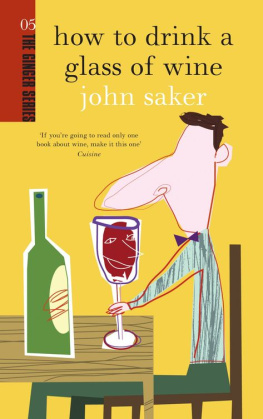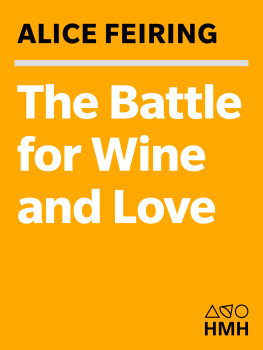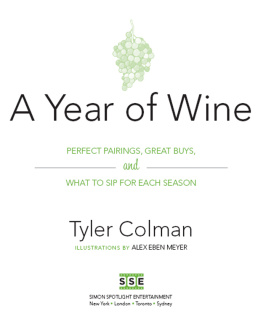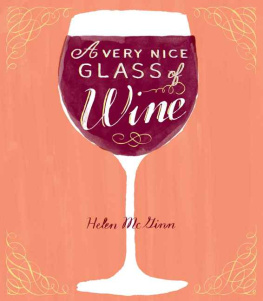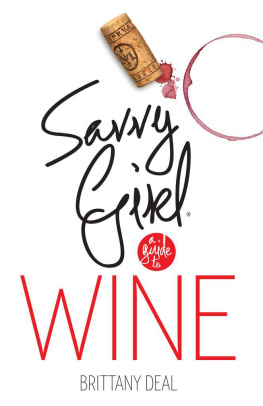Alice Feiring - The Dirty Guide to Wine: Following Flavor from Ground to Glass
Here you can read online Alice Feiring - The Dirty Guide to Wine: Following Flavor from Ground to Glass full text of the book (entire story) in english for free. Download pdf and epub, get meaning, cover and reviews about this ebook. year: 2017, publisher: Countryman Press, genre: Art. Description of the work, (preface) as well as reviews are available. Best literature library LitArk.com created for fans of good reading and offers a wide selection of genres:
Romance novel
Science fiction
Adventure
Detective
Science
History
Home and family
Prose
Art
Politics
Computer
Non-fiction
Religion
Business
Children
Humor
Choose a favorite category and find really read worthwhile books. Enjoy immersion in the world of imagination, feel the emotions of the characters or learn something new for yourself, make an fascinating discovery.

- Book:The Dirty Guide to Wine: Following Flavor from Ground to Glass
- Author:
- Publisher:Countryman Press
- Genre:
- Year:2017
- Rating:3 / 5
- Favourites:Add to favourites
- Your mark:
- 60
- 1
- 2
- 3
- 4
- 5
The Dirty Guide to Wine: Following Flavor from Ground to Glass: summary, description and annotation
We offer to read an annotation, description, summary or preface (depends on what the author of the book "The Dirty Guide to Wine: Following Flavor from Ground to Glass" wrote himself). If you haven't found the necessary information about the book — write in the comments, we will try to find it.
Discover new favorites by tracing wine back to its roots
The Dirty Guide to Wine: Following Flavor from Ground to Glass — read online for free the complete book (whole text) full work
Below is the text of the book, divided by pages. System saving the place of the last page read, allows you to conveniently read the book "The Dirty Guide to Wine: Following Flavor from Ground to Glass" online for free, without having to search again every time where you left off. Put a bookmark, and you can go to the page where you finished reading at any time.
Font size:
Interval:
Bookmark:

FOR OUR MOTHERS, EARTH, AGNS, AND ETHEL
Nor indeed can all soils bear all things. By riversides willows grow, and alders in thick swamps; barren mountain-ashes on rocky hills; on the seashore myrtle thickets flourish best; and the god of the vine loves open slopes as yew trees do the freezing north.
Virgil, The Georgics: Book II

By the gods, Socrates, I am lost in wonder (thaumaz) when I think of all these things. It sometimes makes me quite dizzy.
Plato, Theaetetus
A s usual, we were late and rushing to the next appointment, driving fast through the barren January Anjou landscape. Alice was next to me and friends tasting with us were in the back. We had just left one appointment at a manor carved out of the rock that made the region special: yellow tuffeau limestone. The wine we tasted there, grown on that white and jaundiced soil, was from Chenin Blanc. It was dancing, lingering, salty, timeless. But just a few miles away, where we were headed now, the landscape changed from limestone to schist. I told the girls in the back of the car, We are entering the dark side, the Anjou Noir.
Within minutes, we were in a garage cellar, tasting a Chenin from the very slope we had driven down. So different from the earlier one, this Chenin was powerful and tannic and just as lively, if not more. That schist had to have something to do with it. One afternoon. Two sensitive, vignerons-gardeners with their micro-vineyards, two transparent Chenins. Two expressions of their place: Anjou Blanc and Anjou Noir. By that point, Alice and I had tasted so often together we didnt need words. We looked at each other and knew what the other was thinking: There you go. Proof again of the beauty and the reality of dirt.
Dirt was probably why Alice and I got along right awayand the genesis of this book can be found in our first meeting, ten years ago. It was in Paris in 2007, during a tasting organized by low-intervention vignerons, Patrick Desplats, Jean-Marc Brignot, and Julien Courtois. I was playing the sommelier and Alice was there to taste these very naturally made wines.
All in the room were like-minded and believed that a real wine could only be produced from vineyards carefully observed and taken care of with no synthetic chemicals, where the vines were in tune with the biodiversity around, so the plants could produce the best possible fruit. The vinification would not need any trick, just a wise assist from the vigneron, to produce an honest wine that would change in every year as the season changes every year.
The first wines I shared with Alice expressed all of these elements. Every wine I have cared about since was viewed in that way. Dirt has become a fascinating way of discovering the world of wines.
When I decided to become a sommelier, I went through rigorous professional training. I was taught to approach wines analytically. I learned the facts and data behind the different appellations and grape varieties; I practiced deductive tasting to recognize the structure and the aromatics, to identify the technical faults; I received templates to facilitate grasping the wine worlds complexities. And, indeed, knowing all these things left me with a certain feeling of securityfor a short time.
The feeling of safety ended when I realized the tools did nothing to help me understand the wines I was the most attracted to. Those analytic criteria were condemning the bottles I cared about because they were not the norm. Wines were segregated into camps, using some ideas developed by the French philosopher Bergson, on the mechanical side. Thats where brix + min % + pH + etc. = wine. Yet, to me, on the organic and the natural side, the wines that I considered alive could not be quantified by sums of parts. These wines needed to be taken as a whole; the fundamental cell division, with its own inner balance. So, after all of that training, I was not prepared to analyze these types of alive wines that left me deeply amazed, puzzled, and astonished. And so it appeared that a lot of that wine world was full of ideas and concepts not appropriate to grasp what they were talking about, leading to false problems, like the hot topic right now of minerality. Minerality has become a dirty word par excellence.
In a society reliant on reductionist thinking, the link of dirt to the glass has come under attack. The pundits call this minerality, and it is a false problem.
Theres no minerality in wine.
One cannot taste the small oyster shells, Exogyra virgula, in a Chablis or the taste of basalt in wines from Mount Etna.
But yet, even if the scientists and the technical wine people tell us it isnt so, that doesnt mean that a sense of place doesnt get delivered and that dirt and soil dont have a part in it. Even if no one really yet understands how this can happen. Science is a work in progress trying to understand the vital impetus, within the limits of our mind.
So this book is not a scientific one, and even less an anti-scientific book. It is not a geology nor a geography book. This is not a book to give proof that you can taste rocks in your wine. It is an emotional one in the way that the only wines worth drinking are emotional.
No, instead The Dirty Guide to Wine is an invitation to taste the wine world through new landscapes and new perspectives; an invitation to connect places and bottles, through the looking glass of the soils derived from their underlying bedrock. And please do understand that often the word soil is used here as a shorthand for just that. It is supposed to make you ask even more questions, open the taste buds to new experiences. The more we wrote the book, the more we knew what we did not know. We can not bring any answers, as all of the vignerons who we met and talked with were puzzled, and indeed amazed, by the relationship between the vines and the wines. They were all humble and aware of their lack of understanding of such mysteries, even as their experience grows. The fascinating and always changing synergy between a grape, a terroir, a vintage, a man (or a woman) captured in a bottle.
One summer day, thanks to Alices recommendation, I found myself in Tbilisi, Republic of Georgia. This trip was to greatly change my vision of wineas part of everyday life and not only as a luxury commodityand my approach to tasting. I had the most unusual, thought-provoking experience. My host, painter, vigneron, cook, and singer John Wurdeman, was attempting to realize a lingering idea he had developed while traveling the different regions of his adoptive country: to experience synesthesia. Through rhythm, tonality, and structure between the local dishes, wines, and song of six major provinces of Georgia. And there we were, guinea pigs feasting over five hours with our ears, palates, and brains. Two typical dishes were served, two or three traditional wines made in qvevri were poured, while a couple of men were singing polyphonic songs, the patterns and vocabulary of which were unique to that territory. It was too overwhelming, and my extremely limited knowledge of Georgian culture limited my ability to understand. But I felt a connection, and I could not deny the possibility that synesthesia, or terroir in that case, could be experienced in songs or wines or food. That day I realized how much intuition and amazement could enlarge my vision, and my pleasure. That tasting was an incredible catalyst for this book: Just because the invisible wonder of the dirt cant be seen, and its influence on the vines and the wines cant be formally and decidedly quantified, doesnt mean there is no connection. And if we cant understand it yet, we can already appreciate it and stand for it.
Next pageFont size:
Interval:
Bookmark:
Similar books «The Dirty Guide to Wine: Following Flavor from Ground to Glass»
Look at similar books to The Dirty Guide to Wine: Following Flavor from Ground to Glass. We have selected literature similar in name and meaning in the hope of providing readers with more options to find new, interesting, not yet read works.
Discussion, reviews of the book The Dirty Guide to Wine: Following Flavor from Ground to Glass and just readers' own opinions. Leave your comments, write what you think about the work, its meaning or the main characters. Specify what exactly you liked and what you didn't like, and why you think so.

